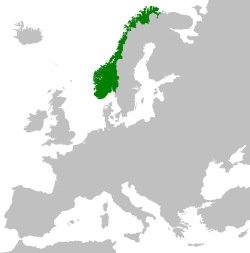Kingdom of Norway (1814)
| Kingdom of Norway | ||||||||||
| Kongeriget Norge | ||||||||||
| Self-proclaimed state | ||||||||||
|
||||||||||
|
Motto Enig og tro til Dovre faller "United and loyal until the mountains of Dovre crumble" Royal motto Gud og fædrelandet "God and the fatherland" |
||||||||||
|
Anthem Norges Skaal "Norway’s Toast" |
||||||||||
|
The Kingdom of Norway in 1814.
|
||||||||||
| Capital | Christiania | |||||||||
| Languages | Dano-Norwegian koiné, Danish written, Norwegian dialects, Sami languages | |||||||||
| Religion | Lutheranism | |||||||||
| Government | Constitutional monarchy | |||||||||
| King | ||||||||||
| • | 1814 | Christian Frederick | ||||||||
| First Minister | ||||||||||
| • | 1814 | Frederik Gottschalk von Haxthausen | ||||||||
| Legislature | Storting | |||||||||
| • | Upper house | Lagting | ||||||||
| • | Lower house | Odelsting | ||||||||
| Historical era | Napoleonic Wars | |||||||||
| • | Treaty of Kiel | 14 January 1814 | ||||||||
| • | Meeting of Notables | 16 February 1814 | ||||||||
| • | Constitution adopted | 17 May 1814 | ||||||||
| • | Swedish–Norwegian War (1814) | 26 July 1814 | ||||||||
| • | Convention of Moss | 14 August 1814 | ||||||||
| • | Union with Sweden | 4 November 1814 | ||||||||
| Area | ||||||||||
| • | 1814 | 324,220 km² (125,182 sq mi) | ||||||||
| Population | ||||||||||
| • | 1814 est. | 902,100 | ||||||||
| Density | 2.8 /km² (7.2 /sq mi) | |||||||||
| Currency | Rigsdaler | |||||||||
|
||||||||||
1814 was a pivotal year in the history of the Kingdom of Norway. It started with Norway in a union with Denmark, subject to a naval blockade by The British Empire, being ceded to the King of Sweden. In May a constitutional convention declared Norway independent. By the end of the year the Norwegian parliament had agreed to join with Sweden in a personal union under the monarch of Sweden. Although nationalist aspirations were not to be fully realized until the events of 1905, 1814 was the crisis and turning point in events that would lead to a fully independent Norway.
The year contains the story of one king and two ambitious future kings in Scandinavia who may have hoped to unite Sweden, Denmark, and Norway under their throne. The Norwegian people and their leaders were caught in the middle of this rivalry, attempting through the crisis to create a measure of self-determination.
Denmark–Norway had become entangled on the French side in the Napoleonic War through its participation in the Gunboat War. Having lost its fleet, it was virtually defenceless as the tides turned against France. The British Royal Navy had blocked all Norwegian ports effectively from 1808, thus breaking many bonds to Denmark, and leaving Norway to itself. Under those conditions, tension grew in Norway, and a fledgling independence movement was formed in 1809. The Swedish campaign against Norway in 1808-09 had been repulsed by the Norwegian army, something that made Norwegians more prone to independence.
...
Wikipedia


